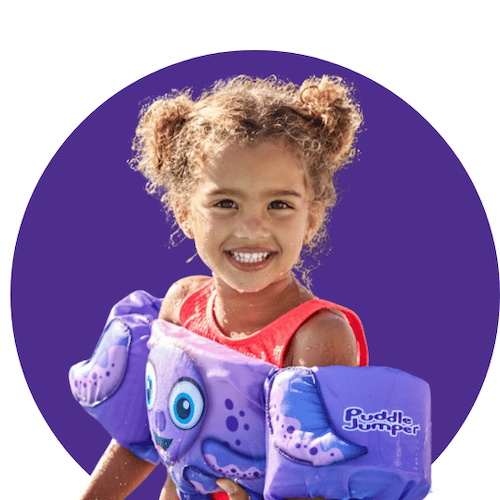Puddle Jumpers 101 : Why Puddle Jumpers Aren’t Safe for the Pool & What Parents Need to Know
You have likely been at a pool and watched kids bob up in down in their lifejackets. Most likely in a puddle jumper. You may have also heard they are terrible devices for swimming. Why is that? Let’s answer some questions and look at better options to use for your next pool day.

What is a Puddle Jumper?
A puddle jumper is a Coast Guard-approved life jacket. It was arm cuffs, a front chest piece, and a secure buckle on the back. These devices are excellent choices for water safety for activities like boating, kayaking, paddleboarding, and more!
A life jacket sounds like a great idea around water, especially a pool. Let’s chat about why this isn’t the case and what I recommend instead.
What’s Great About Puddle Jumpers
This specific style of a lifejacket (along with other PFDs) is that they are safe, keeps your child’s head out of the water and are Coast Guard Approved for open water.
Why are Puddle Jumpers not a safe option for the pool?
The problem with this style of life jacket (along with other vests and water wings) is they keep your child vertical in the water. This is referred to as the drowning position. Scary, right?
These devices also give your child a false sense of confidence. They are floating, kicking, and having fun one minute. They remove (0r someone else removes) the puddle jumper, they dive in and can’t swim. What happens next?
What should you do instead?
Of course, I recommend you enroll your child in group swim lessons, private swim lessons, or teach your child how to swim. If you aren’t sure where to begin with teaching your child, I recommend THIS book. I’m a bit biased since I wrote the book. I lay out all of the best teaching tips to give your child a safe, fun, confident swimming experience.
I know that you may have multiple children and still need some type of flotation device. I recommend this Swimming Backpack. Unlike the puddle jumper, with the backpack, your child can float, use their arms, and begin to be more horizontal in the water. You can also remove a layer as your child becomes more confident. It’s a great tool to give a little confidence while also aiding your child in learning how to swim.
Questions?
Do you have more questions? Let’s chat! I’m here to help you all along your swimming journey. Send me an email.
Thanks for stopping by!
Looking for more ways to teach your child to swim and keep them safe around water? Check out these resources:
- 📚 My book: Teach Your Child to Swim—a step-by-step guide packed with tips to build water confidence and skills. Order it here.
- 🖥️ My online courses: Designed for parents of infants and kids, these lessons make learning to swim fun and easy at home. Learn more here.
- 🌞 More tools and tips: Visit SunshineSwimAcademy.com for free resources, expert advice, and everything you need to make water safety a priority.
- 💖 Donate to Step Into Swim: Help provide free swim lessons to other young swimmers and make a difference in water safety. Donate Here.
Let’s make waves together! 🌊

